From the Beginning. THE SNAKE was there in the Garden, with his own version of TRUTH. Cast out of the Garden, humans grew more and more sinful. In time, they forgot the Garden and GOD. They followed their own lusts and the enemy of their soul told them lies. The fallen Angels taught them secret knowledge. As time moved on, those who held the “secret knowledge” used it to Lord over the masses. The secret societies were born.
In every nation, there were those who ruled and those who served. The elite kept their secrets guarded because they kept the people at their mercy. Those who forget GOD and turn their back on TRUTH, are, even today slaves to that which they worship. There is a hierarchy on this earth. There are ruling spirits over territories. There are familiar spirits over bloodlines.
The rulers of this world both human and spirit rule through fear, and control by deception and lies. DEMONIC FORCES do have POWERS and those who serve them and/or worship them are able to access those powers through sacrifice and rituals. Demonic Spirits have the power to use natural forces of nature. They can call down fire and lightning, form clouds, change the wind, stir up the waters, dry out the land, etc. at will for their purposes.
In this post we will look at the connection between magic and science.
spacer
If you have not seen the following posts on this topic, check them out
spacer
Do You Believe in Magick? Part 16 – Science is MAGICK/WITCHCRAFT
Gifts from the Fallen – Part 2 – Sacred Arts, Sciences and Crafts
BARD MAGIC – ILL-LUMA-NATION
Science – The MagicK that will DESTROY Mankind
Magic Sword of the Elite
SCIENCE – The Deception is designed to destroy our faith in the WORD of God
spacer
magic (n.)
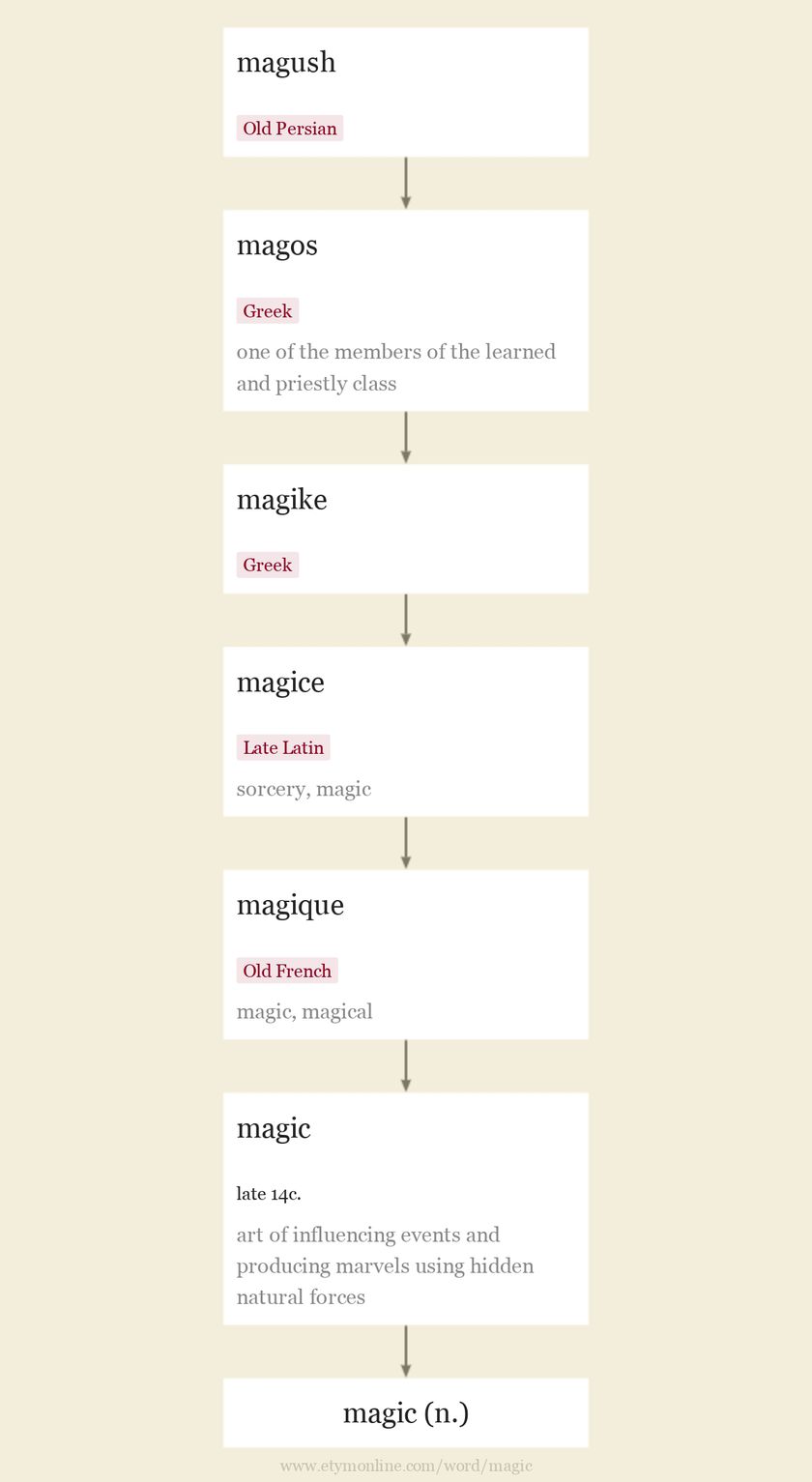 late 14c., magike, “art of influencing or predicting events and producing marvels using hidden natural forces,” also “supernatural art,” especially the art of controlling the actions of spiritual or superhuman beings; from Old French magique “magic; magical,” from Late Latin magice “sorcery, magic,” from Greek magike (presumably with tekhnē “art”), fem. of magikos “magical,” from magos “one of the members of the learned and priestly class,” from Old Persian magush, which is possibly from PIE root *magh- “to be able, have power.” The transferred sense of “legerdemain, optical illusion, etc.” is from 1811. It displaced Old English wiccecræft (see witch); also drycræft, from dry “magician,” from Irish drui “priest, magician” (see Druid). Natural magic in the Middle Ages was that which did not involve the agency of personal spirits; it was considered more or less legitimate, not sinful, and involved much that would be explained scientifically as the manipulation of natural forces.
late 14c., magike, “art of influencing or predicting events and producing marvels using hidden natural forces,” also “supernatural art,” especially the art of controlling the actions of spiritual or superhuman beings; from Old French magique “magic; magical,” from Late Latin magice “sorcery, magic,” from Greek magike (presumably with tekhnē “art”), fem. of magikos “magical,” from magos “one of the members of the learned and priestly class,” from Old Persian magush, which is possibly from PIE root *magh- “to be able, have power.” The transferred sense of “legerdemain, optical illusion, etc.” is from 1811. It displaced Old English wiccecræft (see witch); also drycræft, from dry “magician,” from Irish drui “priest, magician” (see Druid). Natural magic in the Middle Ages was that which did not involve the agency of personal spirits; it was considered more or less legitimate, not sinful, and involved much that would be explained scientifically as the manipulation of natural forces.magic (adj.)
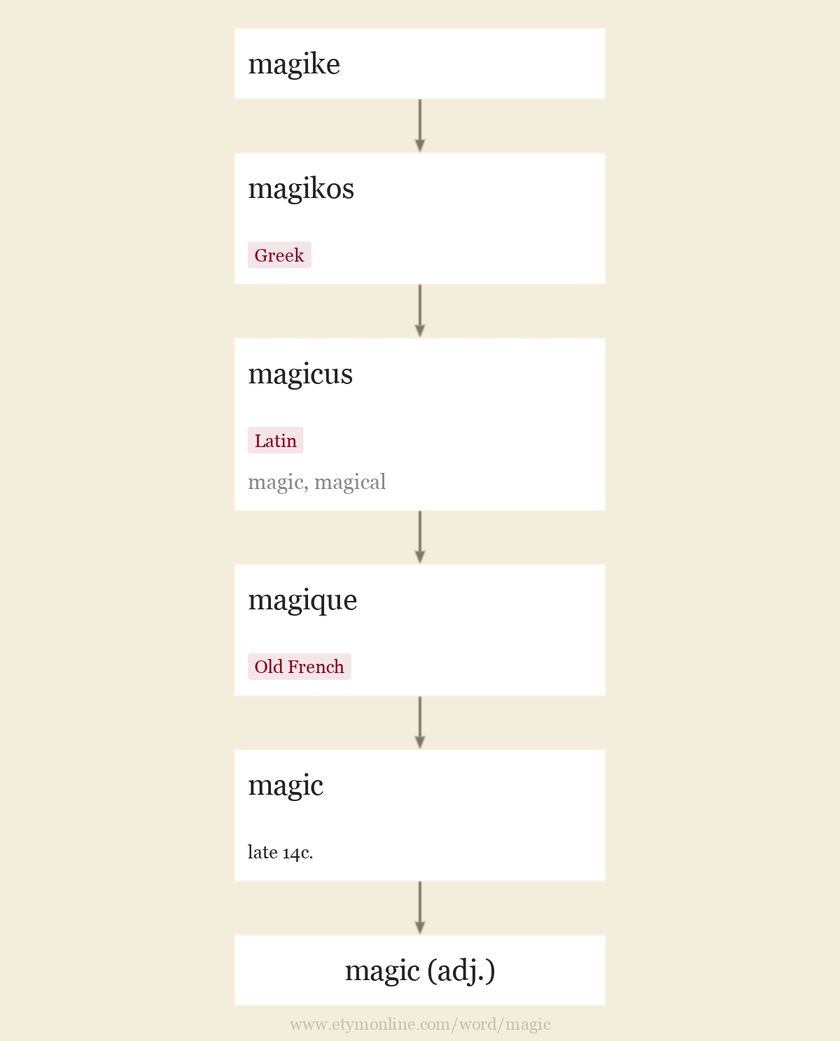
science (n.)
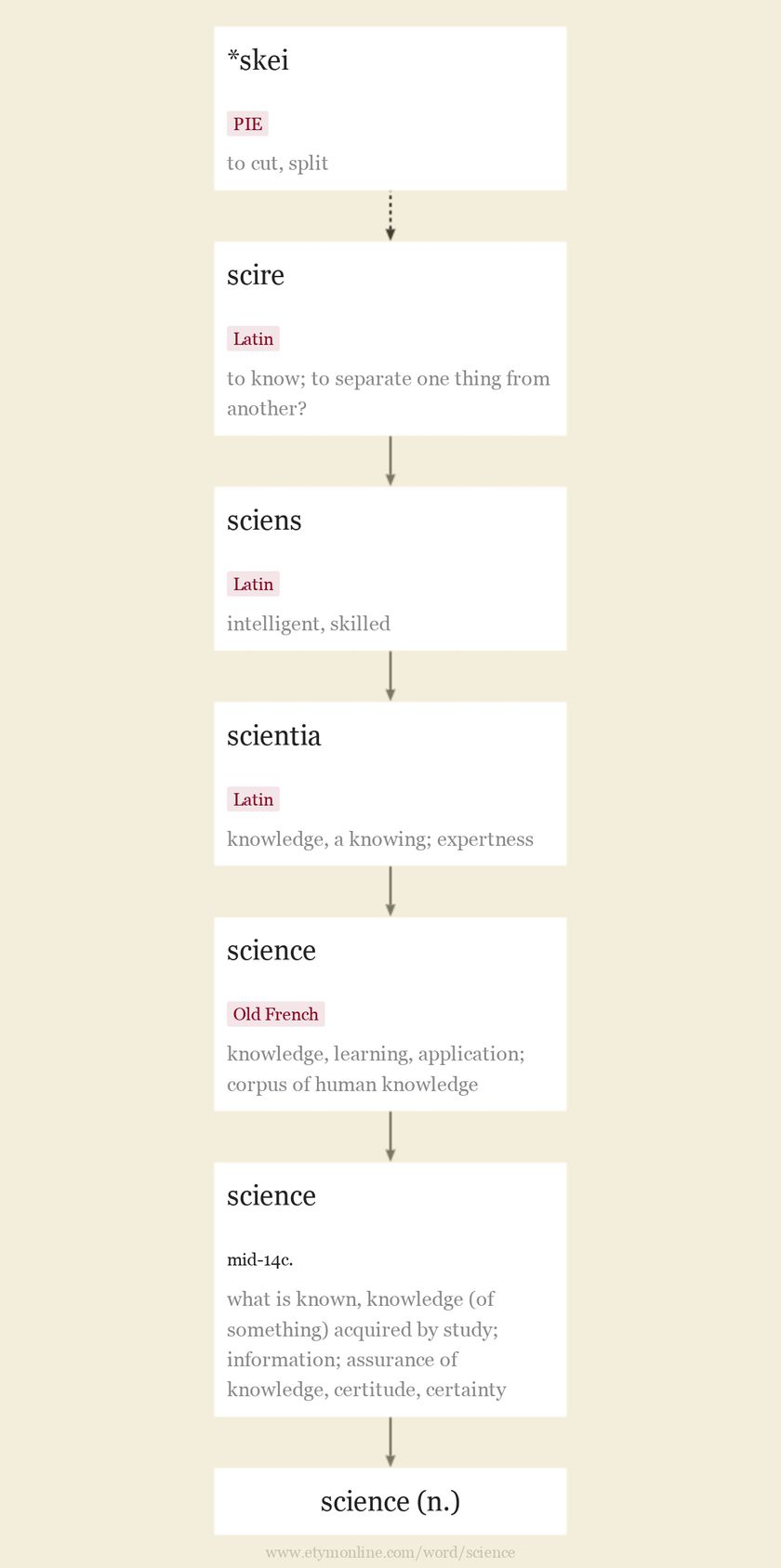
spacer
Excerpts from Druidism: the Ancient Faith of Britain
Every Druid wore around his neck, encased in gold, what was known as the angiiinum, or ” Druid’s Egg.” Pliny, in his Natural History, gives the following account of it :
| ” There is, besides, a kind of egg held in high esteem by the inhabitants of Gaul, unnoticed by the Greek writers. It is called ‘ the serpents’ egg ‘; and, in order to produce it, an immense number of serpents, twisted together in summer, are rolled up in an artificial folding by the saliva of their mouths and the slime of their bodies. The Druids say that this egg is tossed on high with hissings and that it must be intercepted in a cloak before it reaches the ground. The person who seizes it flies on horseback, for the serpents pursue him till they are stopped by the intervention of some river. The proof of this egg is, that, though bound in gold, it will swim against the stream. And, as the magi are very artful and cunning in concealing their frauds, they pretend that this egg can only be obtained at a certain time of the moon, as if this operation of the serpents could be rendered congruous to human determination. I have indeed seen that egg of the size of an ordinary round apple, worn by the Druids in a chequered cover resembling the enormous calculi in the arms of a polypus. Its virtue is highly extolled for gaining law suits and procuring access to kings ; and it is worn with so great ostentation that I knew a Roman knight by birth, a Vocentian, who was slain by the Emperor Claudius for no cause whatever except wearing one of these eggs on his breast during the dependence of a lawsuit.” |
It is not improbable that this egg and the alleged marvellous manner of its production had connection with some primary dogma which Pliny never fathomed. Hughes, in Hora Britannica, says that in the writings of the ancient Bards several allusions to what he terms the ” mummery “
are to be found, one of which he quotes as follows :
| ” Lively was the aspect of him, who, in his prowess, had snatched over the ford that involved ball which casts its rays to a distance ; the splendid product of the adder, shot forth by serpents.” |
The Druids themselves were called Nadredd, or snakes, by the Welsh Bards ; and the whole of the tale mentioned by Pliny has a mystical reference to the difficulty of attaining Druidical secrets and the danger of disclosing them. There is, of course, no doubt that this famous object of Druidic superstition was merely artificial. The art of making these trinkets being known only to the Druids, they availed themselves of the credulity of the common people, to magnify the virtues of them and to give them a mysterious import.
The serpent was a sacred reptile among the Druids. They supposed its spiral coils to represent the eternal existence of the Almighty. Camden tells us that in many parts of Wales and throughout all Scotland and Cornwall it is an opinion held by the people that about Midsummer Eve the snakes meet in company and that by joining heads together and hissing, a kind of bubble is formed, which, by continually being blown upon, passes through the body, when it immediately consolidates and resembles a glass ring, which, whoever finds, shall prosper in all his undertakings. The rings thus generated are called Glcinunadroeth, or “ snake stones.” Wirt Sikes, in British Goblins, says that the snake stone is a striking W’elsh tradition associated with Midsummer Eve, and there is a Welsh saying respecting people who lay their heads together in conversation that the talkers are ” blowing the gem.”
Any water poured on the serpents’ eggs is said to have had wonderful life-giving power and become able to produce life. It has also been asserted that the Druids were wont to place live serpents at the foot of the altar during the time of sacrifice.
In Scotland, the Druids’ egg was known as an adder stone, and it was in great reputation for the foretelling of events, the working of miracles, the curing of disease, and the gaining of law suits.
In the Scottish Museum there is a bead of red glass, spotted with white ; another of dark brown glass, spotted with yellow ; others of pale green and blue glass, plain and ribbed ; and two of curiously figured patterns, wrought with various colours interwoven in their surface.
These glass baubles were badges and passports that the bearers were loi initiated, and whoever purloined or carried one without authorization was pursued by the deadly vengeance of the Brotherhood. The amulet was variously shaped. Sometimes it was like a round bead of glass ; at others, like a crescent with a glass boat ; sometimes it was a glass circle, and sometimes it resembled a glass house. In every case it was regarded as a powerful talisman. Camden has thus described these magical appendages :
| ” These geminse anguinje are small glass amulets, commonly as wide as our finger rings, but much thicker ; of a green colour usually, though some of them are blue, and others curiously waved with blue, red, and white.” Specimens have frequently been found in the Isle of Anglesea. Smaller consecrated beads—white for Druids, blue for Bards, and green for Ovates—were carried by the individuals and interred with them at death. A number of these beads were found in an excavation made at Quarrington in 1828. Taliesin, speaking of a warrior’s amulet, says : ” Beautiful is the circle with its enriched border.” The anguinum was not known in Ireland, the reason given by Llhwyd, the antiquarian, being : ” The Druid doctrine about the Glain Neidr obtains very much throughout all Scotland, as well lowlands as highlands ; but there is not a word of it in this kingdom (Ireland), where, as there are no snakes, they could not propagate it. Besides snake-stones, the highlanders have their small snail stones, paddock stones, etc., to all which they attribute their special virtues and wear them as amulets.” |
In another letter, referring to the same subject, he says :
| ” The Cornish retain a variety of charms, and have still towards the Land’s End the amulet of Mael Magal and Gelin Nedir, which latter they call a Milpreu, or Melpreu, and have a charm for the snake to make it, when they have found one asleep and struck a hazel wand in the centre of her spires.” |
Edwards supposes that the Welsh Bardic title of Nadredd is to be traced to the belief in transmigration. The serpent, which sheds its skin annually and appears to return to a second youth, may have been regarded by them, as well as by other people of that time, as a symbol of renovation, and this renovation or reincarnation was the great doctrine set forth by the Arkite mysteries and by the symbolical egg.
Mason, in Caractacus, has described the ceremony of securing the anguinum in the following words
Among other achievements, the Druids have been credited with the power to drive a man insane simply by flicking a wisp of straw, which was called Dlui fulla, in his face.
At the famous battle of Culdreimne (Coolcrevny) in a.d. 560, according to the Annals of Ulster : ” Fraechan, son of Temnan, it was that made the Druids’ erbe for Diramit. Tuatan, son of Diman, it was that threw overhead the Druids’ crheP The same author is responsible for the statement that in a.d. 738, ” Fergus Glutt, king of Cobha, died from the envenomed spittles of evil men.”
The belief that magical powers were in the possession of certain individuals was retained, as will be seen, until well on in the Christian era. Sopater, the philosopher, and friend of Constantine, was accused of binding the winds in an adverse quarter by the influence of magic, so that warships could not reach Constantinople, and, in response to ecclesiastical clamour, the Emperor was compelled to issue the order for his decapitation.
Belief in witchcraft can be traced to Druidism, and some of the practices attributed to witches after all traces of Druidical worship and customs were supposed to have died out are nevertheless exact, or almost exact, reproductions of the practices attributed to the Druids by earlier authorities. More than one writer has stated that the Scottish witch is the direct descendant of the Druidess, and, according to Pomponius Mela, the Druidesses of the Isle of Sena could grant fair winds or raise tempests, and, in 1792, the author of the Statistical Account of the Hebrides stated that in the island of Gigha it was believed that by performing certain ceremonies at a fountain there, persons thus initiated into its mysteries could cause the wind to blow from any quarter desired.
Concerning Druidesses, however, much controversy has arisen, some even disputing their existence. Most writers, however, agree that there were Druidesses and that they were divided into three classes, but none performed priestly duties. The members of the first, or highest, class took vows of perpetual virginity, and were regarded as the elite of the order. Their duty was to attend to the sacred fire, and they were known as Inghean an Dagha, ” daughters of fire,” but sometimes as Breochuidh, ” fire keepers.” The members of this class lived together in communities, separated from the world. The second class married, but spent the greater part of their time in religious work. They wove the hangings of the groves, made the vestments of the priests, took part in certain of the ceremonies, and performed the ordinary duties of the household. The third class consisted of such as performed the most servile offices about the temples and the priests’ households. In Gaul, the second class, though married, were vowed to continence, remaining always within the temple enclosure, emerging only once a year to consort with their husbands for the purpose of procreation. The third lived at home with their husbands, training their children, but devoting their leisure to work in the temple. Although there, as in Britain, they were dependents and subordinates of the Druids, they, in fact, superintended entirely the divine mysteries and sacrifices, entrance to certain parts of the temples being interdicted to men.
Druidesses appear also to have formed part of the Irish ecclesiastical organization. Toland, in his History of the Druids, speaks of Gealcossa, a Druidess, who resided near Gealcossa’s Mount, in Inisoen, in the county of Donegal. Her name, he says, ” is of Homeric strain, signifying ‘ white-legged.’ On this hill is her grave, and hard by is her temple, being a sort of diminutive Stonehenge, which many of the old Irish dare not at this day in any way profane.” :
The Druids represented the wren as the king of all the birds and e Welsh for king is bren. At one time the raven was regarded by the Greeks as the greatest of soothsaying birds. One of the Druidical proverbs ran as follows :
| He that takes a wren’s nest Will have no health all his life. The well-known song,” The Three Ravens,” is a survival of a Druidic chant : There were three ravens sat on a tree, Down-a-down ! hey down ! hey down. They were as black as black might be With a down ! Then one of them said to his mate Where shall we now our breakfast take. With a down, down, derry, derry-down. |
Every Druid carried a wand. The wand of the British Druids was made from oak, but that of the Irish Druids was made from yew. “a coniferous tree which has red berrylike fruits, and most parts of which are highly poisonous. Yews are linked with folklore and superstition and can live to a great age; the timber is used in cabinetmaking and (formerly) to make longbows.” At the present day, in some Roman Catholic churches, it is a practice, when the faithful approach the confessional, for them to receive a touch on the head from a wand which the priest holds in his hand. In this way also the priests of Isis blessed and exorcised. In Scotland the Rowan, or Mountain Ash, will always be found near holy places and circles or Clachans. It was essential that on Belrane, or May-day, all sheep and lambs should pass through a hoop of the Rowan-tree, and that on all occasions Scottish shepherds should be careful to drive their flocks to the hills with a Rowan wand. In the Scottish isles, where malign influence is feared, it is the custom to place a Rowan branch over the doorposts. Many Highlanders at the present day plant the Rowan, or Mountain Ash, near their dwellings or fields for the purpose of warding off evil spirits. If heather and flowers be added to Rowan wands, important beneficial services on the part of the spirits may be expected,
particularly if all be carried thrice round the fires kindled on the May festival.
The gift of prophecy was also believed to be a power in the possession of the Druids. They claimed to be able to predict future events, not only from holy wells and running streams, but also from rain and snow water, which, when settled and afterwards stirred, either by oak leaf or branch, or magic, might exhibit appearances, which would convey information to the far-seeing Druid, or appear to do so to the credulous inquirer, while the priest was at full liberty to represent the appearance in whatever manner he thought most suited to his purpose. The cauldron of Ceridwen was said to contain the water of inspiration and science. A few drops of this water allowed to fall upon the finger of a person and then put into his mouth would open up futurity to his view. This, however, could only be done on the completion of the course of initiation, when the testing of this water was an essential rite.
The Druids were also experts in the science of psychotherapy. Lady Wilde, in one of her works, says :
| ” The priests and magi of the ancient Druids possessed a wonderful faculty of healing. They were able to hypnotise the patients by the waving of the wand, and, while under the spell of this procedure, the latter could tell what was happening afar off, being vested with the power of clairvoyance. They also effected cures by stroking with the hand, and this method was thought to be of special efficacy in rheumatic affections. They also employed other remedies which appealed to the imagination, such as various mesmeric charms and incantations.” |
Vervain was much used in magical operations and many virtues were ascribed to it. By rubbing themselves with it, the Druids claimed to obtain anything they desired : it banished fevers, cured all sorts of maladies, and reconciled the hearts of those that were at enmity one with another ; sprinkled by way of aspersion upon guests, it had virtue to make those who were touched with it more gay and better pleased than the rest of the company. The medical practitioners held a high and influential place in the Order and occupied a distinguished place at the royal tables, next to nobles, and above the armourers, smiths, and workers in metals. They were also entitled to wear a special robe of honour at the courts of kings, and were always attended by a large number of pupils, who assisted their masters in the diagnosis and treatment of disease and the preparations necessary for the curative potions.
The Druids were inordinately attached to augury and divination, one of their methods being the practice of casting stones into water and counting the number of circular ripples thus formed. Other methods were the Druid’s wheel, sneezing, examination of tree roots, the howling of dogs, and the singing of birds, particularly the croaking of the raven and the chirping of the wren. When St. Kellach, Bishop of Kellala, was about to be murdered, the raven croaked and the wise little wren twittered. After the deed was perpetrated, the birds of prey came scrambling for their share, but every one that ate the least morsel of the saint’s flesh dropped dead. Both Pliny and Cicero bear testimony to the Druidical practice of sortilege or divination. They would foretell the future by the flight of birds and by the inspection of the entrails of victims. All the people would obey them unquestioningly, and it was an established custom among them that no one should offer sacrifice if a philosopher were not present. It was claimed that no one could offer sacrifices acceptable to the gods except through the intermediary of these men who knew the divine nature with which they were supposed to be in communication.
Tacitus, in Germania (c. x.), speaks of a full-grown tree from which a branch was severed and afterwards divided into small cuttings which were marked and then flung upon a white cloth, and, as the sticks fortuitously fell, the diviner interpreted fates.
According to Dechelette, the Druidical teaching with regard to numbers is of more ancient origin than the Pythagorean. The Pythagorean philosophy flourished in the fifth and sixth centuries B.C., and it is supposed that at this time the Celtic civilization became subject to Grecian influence, and coming from meridional Italy, this was an influence not only on industry, but also on morals, and the Celts are supposed to have modified their funeral customs through contact with the Italian people.
Odd numbers were appropriated to the celestial and even ones to the infernal deities, and in all the occurrences of life, the former were accounted fortunate. A predilection in favour of odd numbers still persists among most peoples. Thus, in domestic concerns, a hen is usually set on an odd number of eggs. Palladius says that the same thing was done in his time. Druidic divination also consisted in watching the direction of smoke from fire. Sometimes the Druid would chew a bit of raw flesh, muttering at the same time an incantation and an
invocation to the gods, when he claimed that generally the future would be revealed to him. Sometimes he would place his hands upon his cheeks and fall into a divine sleep : this was known as ” illumination by the palms of the hands.” Fionn was in the habit of biting his thumb continually when he was seeking superhuman knowledge. According to Dr. Joyce, the Irish Druids made their divinations from observations of the clouds. Diodorus Siculus gives the following account of one of the Druidical methods of divination :
| ” On great occasions they practise a very strange and incredible manner of divination. They take a man who is to be sacrificed and kill him with one stroke of the sword above the diaphragm ; and, by observing the posture in which he falls, his different convulsions, and the direction in which the blood flows from his body, they form their predictions, according to certain rules which have been left them by their ancestors.” ” And, leaning o’er the victims as they died. Explored the future in the gushing tide. Oft as the blood, impelled with various force To right or left, directs its headlong course. They saw some bless’d event, or traced with skill Divine, some signal of impending ill.” |
Mallet, in Northern Antiquitifs, says that when the Swedes offered up animals in sacrifice, they speedily killed them at the foot of the altar ; they then opened their entrails to draw auguries from them, as among the Romans.
spacer
The magical origins of science. A look at the philosophical tradition
The Magical Origins of Science. A Look at …
Orbis Idearum
Variant title
Abstract
The idea that the occult or esoteric sciences – in particular magic, alchemy, and astrology – have played a significant role in the birth of modern science has gained a solid position in the metascientific literature of the last two centuries. This idea is certainly controversial, but not more controversial than other theories of the origins of science. Indeed, the theory that modern science simply emerged from common sense, once all the traditional theological impediments were removed, as well as the theory that identifies the roots of modern science in the Judeo-Christian beliefs, have also both met with severe criticism. This article presents the thought of four philosophers who paved the road for the theory of the magical origins of science, namely Francis Bacon, Auguste Comte, Arthur Schopenhauer, and Friedrich Nietzsche. Their insights have subsequently been developed by social scientists and historians of science. A brief account of these developments will be also given in the conclusions.
30/08/2019s
pacer
Science is a kind of magic
The science of magic and the magic of science

Sometime in the 15th century, a group of university students got together in the town of Oberdorf in Bavaria to do what students have done the world over: drink beer. After they had been at it for a while, they decided that whoever fetched the next round wouldn’t have to pay for it. One student went to get beer, but on opening the door, he saw an unusually dark fog and he refused to go out. Then, a foolhardy member of the group boasted, “Even if the Devil was present, I shall fetch the drinks.” To their consternation, those in attendance all saw the man borne aloft into the air, shouting as he was carried out the door by an invisible demon in the direction of further libations.
This event is recounted in the Malleus Maleficarum (The Hammer of Witches), a 1486 text so infamous that it has been described “the most significant ‘witchhunting’ guide published in early modern Europe” and as “without question the most important and sinister work on demonology ever written.” While its influence has probably been exaggerated, it contains a number of striking anecdotes (and a whole lot of misogyny). But from a contemporary vantage, one of the most remarkable things about the text is that it principally denied that witchcraft was supernatural or miraculous. According to the text:
The effects of witchcraft…are done through the power of some creature unknown to us, but they are not miracles, which are things done outside the order of the whole of created nature…. The magician, since he works through a pact entered into with the demon…works by means of the demon, who [operates] by his own natural power. (Part I, Question 5)
Witches were a real danger because they made deals with demons, but their powers were neither miraculous nor supernatural but came from the “natural” powers of those demons, whose capacities and limitations the text explored in great detail.
Science didn’t disenchant reality
This matters because one of the most familiar narratives of our age is one of disenchantment—that the rise of science meant the departure of the supernatural and the production of a new rationalistic world view incompatible with magic and spirits. I’ve elsewhere criticized disenchantment as a historical or sociological claim, but here I want to focus on the presumption that natural sciences automatically banish supernatural magic. The problem is that magical works, like the above, often rejected the supernatural while it was figures associated with the scientific revolution who described their projects in terms of magic, spirits, and sometimes cosmologies requiring the supernatural. So, it would seem that conventional accounts have it exactly backward: disenchanting occult texts were sometimes replaced by enchanting scientific ones. At the very least, it is difficult to sustain a clear line between premodern magic and modern science.
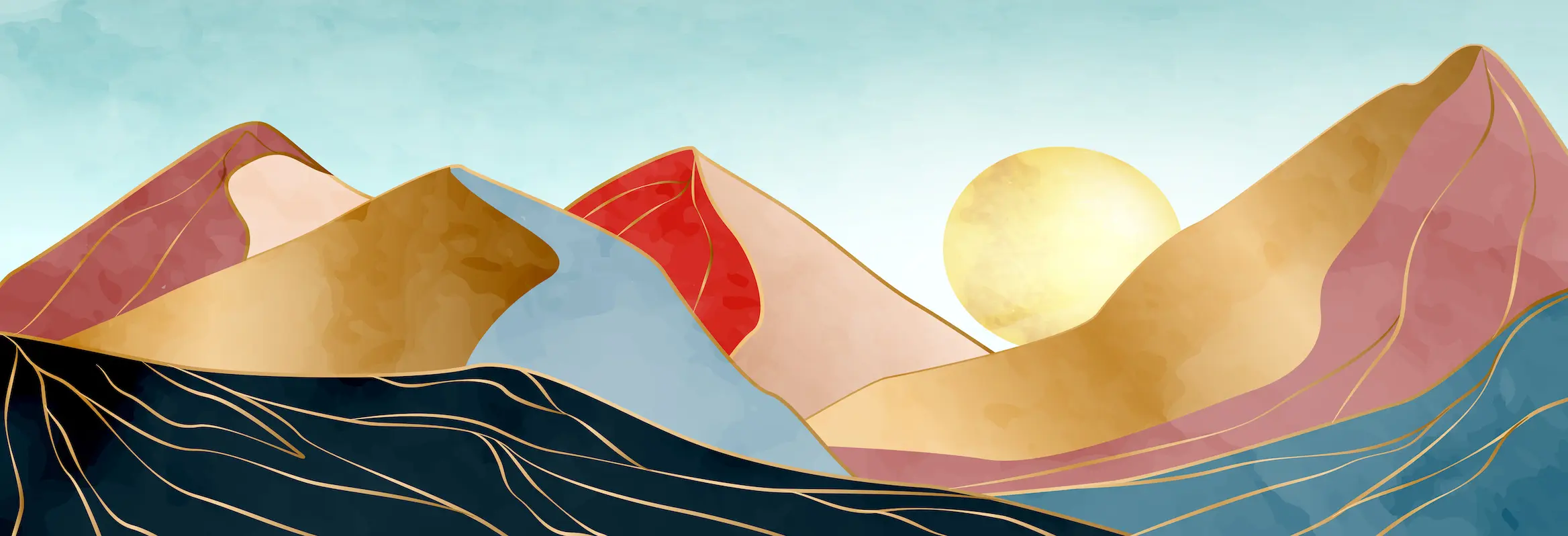 SUGGESTED READINGPhysics can’t deal with reality’s complexityBy Nancy Cartwright
SUGGESTED READINGPhysics can’t deal with reality’s complexityBy Nancy Cartwright
Part of the problem is that the supernatural itself is a red herring. In a broad historical overview, the “supernatural” (Latin supranaturalis) was an inadvertent product of the twelfth century recovery of Aristotle, which had caused the merger of two notions of “nature” (φύσις and naturalis). The problem became how to understand miracles. If miracles were “natural” then that would imply that they weren’t very special. But if miracles were “against nature” (contra naturum), then it would seem that God was unnatural or in violation of divine laws.
To navigate this thorny thicket, thirteenth-century theologians defined divine miracles as “above nature” (supranaturalis). Thus, the “supernatural” was initially referred to a divine exception. A consequence of this categorization was that it relegated demonic “wonders” (mira) and “magic” to the realm of the natural (or sometimes “preternatural,” praeternaturalis indicating a violation of ordinary causation but not natural laws). Not only was there natural magic, but even demonic magic was even in some sense natural. Another inadvertent by-product of this theology was that the Devil became a kind of protoscientist. For instance, as Thomas Browne put it in Pseudodoxia Epidemica, “being a natural magician [the Devil] may perform many acts in ways above our knowledge, though not transcending our natural power…. Many secrets there are in Nature of difficult discovery unto man, of easy knowledge unto Satan.” Nor was Browne alone, a number of Europeans understood magic and technology to be fundamentally related.
There is a further problem with the popular narrative about the rise of science. While a number of candidates have been proposed as the progenitor of the “scientific revolution,” most of these, in some sense, saw themselves as magicians. For instance, Giordano Bruno has been popularly described as a martyr to science, but, now that more of his works are available—including his De magia (On Magic)—it’s clear that Bruno’s aim was not to despiritualize astronomy, as was once thought, but to elaborate an infinite and richly animated cosmos that was full of magical forces, spirits, and demons.
Similarly, the so-called “father of modern science”, Francis Bacon, argued that “Magic aims to recall natural philosophy from a miscellany of speculation to a greatness of works,” which was exactly what he was trying to do with his own project, as is clear from his definition of magic “as the science which applies the knowledge of hidden forms to the production of wonderful operations; and by uniting (as they say) actives with passives displays the wonderful works of nature.” Magic was a pragmatic or instrumentalist form of natural philosophy of exactly the sort Bacon saw as missing from scholasticism. Moreover, although Bacon often gets accused of despiritualizing nature, in texts like Sylva Sylvarum and the Historia vitae et mortis, he described a natural world overflowing with spirits with their own particular powers and appetites. Science, in this account, was the manipulation of spirits, not their elimination.
We could say something similar about Isaac Newton. It is well-known that Newton was obsessed with alchemy and hidden codes in the Bible. But Newtonian physics was also not a stripped-down mechanics, but a dynamic cosmos inclined toward apocalypse and dissolution. Not only was gravity an occult force, but, and this is an important point, Newton’s physics required active divine intervention and the supernatural. As he put it, “nothing is done without [God’s] continual government and inspection,” and added:
For if there be innate gravity, it is impossible now for the matter of the earth and all the planets and stars to fly up from them, and become evenly spread throughout all the heavens, without a supernatural power, and certainly that which can never be hereafter without a supernatural power, could never be heretofore without the same powers.
Paraphrased, Newtonian physics required the supernatural to explain why gravity doesn’t collapse everything together.
Newton has often been described as the last of the magicians, but this was not the case. Historians of science have provided plenty of counterevidence by focusing on individual scientists’ and philosophers’ alchemical experiments, magical preoccupations, or mystic visions—addressing everyone from Robert Boyle to Alfred Russel Wallace to Thomas Edison to Wolfgang Pauli, from the early natural philosophy to quantum physics. Indeed, according to some, science still has its demons. At the very least, as I argue in the book, the mechanization of the world picture is not an accurate description of the history of science. The very act of producing a systematic image of the world is often supposed to have automatically produced the evacuation of meaning and the departure of wonder. But a closer look at the history shows nothing of the sort.
___
Instead of philosophers defending the “scientific worldview” we should really be thinking of the longevity of specific localized theories
___
The rationality of magic, and the demarcation problem
What are we to make of all this?
First, the supernatural is alleged to be what distinguishes magic from science. But the whole natural-supernatural binary was a short-lived product of Christian theology that rarely made sense either at home or abroad. Anthropological descriptions of so-called “primitive witchcraft” or “magical thinking” notwithstanding, non-European cultures lacked indigenous terms for the “supernatural” before the period of contact.
Second, magic is often described as either irrational or its own form of rationality. But premodern Europeans who used the term “magic” seemed to have believed that insofar as magic was efficacious, it worked according to the same principles explored by their theology and philosophy. Magic was not a violation of causation, but rather bounded by the same kinds of natural laws that would be explored by scientific experimentation. In this respect premodern magic was rational.
Third, it is often assumed that magicians must have been irrational not to have noticed that their spells did not work. But the simplistic idea that science is falsifiable, and magic isn’t, is incorrect. One can apply the famous Duhem-Quine thesis to both magic and science alike. A specific experiment or magic ritual never exists in isolation. A background theory can always be modified regardless of outcome. If a spell to summon a storm or an experiment to measure a cannonball’s velocity does not yield the desired result, the failure can always be explained by adjusting auxiliary hypotheses (such as air resistance or the willingness of demons) without considering the grand theory to have been disproved. Hence, no single scientific experiment or magical spell is ever sufficient on its own to support or refute a theory.
Finally, on a philosophical level, a key issue is the problem of demarcation. It is harder to demarcate the boundaries of magic and science than is popularly supposed. There is no single scientific method that all the sciences share. Knowledge is produced differently in different scientific disciplines. Attempts to define science in terms of falsifiability have been unsuccessful. Part of the meaning of science comes from its putative opposition to magic. But this opposition cannot be fully maintained. Every attempt to define science to include astronomy but exclude astrology turns out to either leave out a well-recognized science or include a denigrated pseudoscience. Popular statements often treat science as a unitary agent. But there is not one science, nor one scientific consensus.
Does this critique of the unity of science lead us into a grand abyss of unknowing? No. Many contemporary debates are really about confidence about the contemporary scientific cosmology. Yet if science is not a unity, then all these conversations are misguided. Instead of philosophers defending the “scientific worldview” we should really be thinking of the longevity of specific localized theories. Whether or not quarks are merely mind-dependent, or part of the universe is a question for physicists in a field that already has methods for adjudicating such issues. The social construction of quarks is not a grand issue for science as a whole, because there is no science as a whole to be attacked or defended. But this should not be seen as a tragedy, we do not actually need an inflated and universalized category of “science” to support the search for knowledge. Nor does the advancement of knowledge necessarily mean the end of wonder.
Jason Ānanda Josephson Storm
8th February 2023
 |
 |
Abstract

In Masonry and Magic, Blending Illusion and Wonder

spacer
 Freemasonry and the Birth of Modern Science
Freemasonry and the Birth of Modern Science
space
Freemasonry is Spiritual Alchemy by RW Dr. Christopher Earnshaw

spacer
spacer
Illuminati Symbolism and Beliefs
The supreme goal of the Bavarian Illuminati was to live without government and religious interference. Weishaupt’s vision was to create a new world order through a universal republic where everyone would live in a world of equality, social fraternity, and atheism. He believed in reason and science free of moral and religious constraints.
These were radical ideas in a time when the Roman Catholic Church controlled philosophy and science, and the order was concealed using other names and occupations.
The Owl of Minerva was a symbol associated with the Illuminati, and it stood for knowledge, wisdom, and learning. The All-Seeing Eye or Eye of Providence is commonly associated with the Illuminati, particularly in modern times. The eye enclosed in a triangle surrounded by rays of light has also been associated with Freemasonry and serves as a reminder that God always observes humanity’s thoughts and deeds.
spacer
Proof of the Illuminati

spacer
Secrecy is the element that maintains their power over the masses.
There is not a crime, there is not a dodge, there is not a trick, there is not a swindle, there is not a vice which does not live by secrecy.”
―
In order to escape accountability for his crimes, the perpetrator does everything in his power to promote forgetting. If secrecy fails, the perpetrator attacks the credibility of his victim. If the victim cannot be silenced absolutely, he tries to make sure no one listens. (paraphrased slightly)
― Trauma and Recovery: The Aftermath of Violence – From Domestic Abuse to Political Terror
it is the nature of evil to be secret.”
―
Secrecy is the freedom tyrants dream of.
Bill Moyers
The best weapon of a dictatorship is secrecy…
Niels Bohr
SPACER
Hippocrates (Hypocrates) – the Silent, Jokester God

spacer
Keeping Magic Secret [Esoteric Saturdays]
spacer
BUT GOD SAYS:
For nothing is hidden, except to be revealed; nor has anything been secret, but that it would come to light.
For nothing is hidden that will not become evident, nor anything secret that will not be known and come to light.
spacer
President Kennedy spoke of secrecy and made it very clear what role it should play in our society:
The very word ‘secrecy’ is repugnant in a free and open society; and we are as a people inherently and historically opposed to secret societies, to secret oaths, and to secret proceedings.
spacer
Quantum Magic [Esoteric Saturdays]
spacer
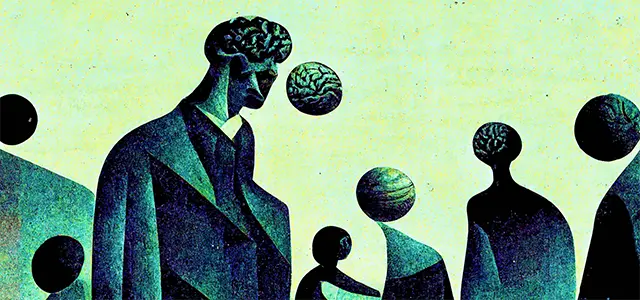
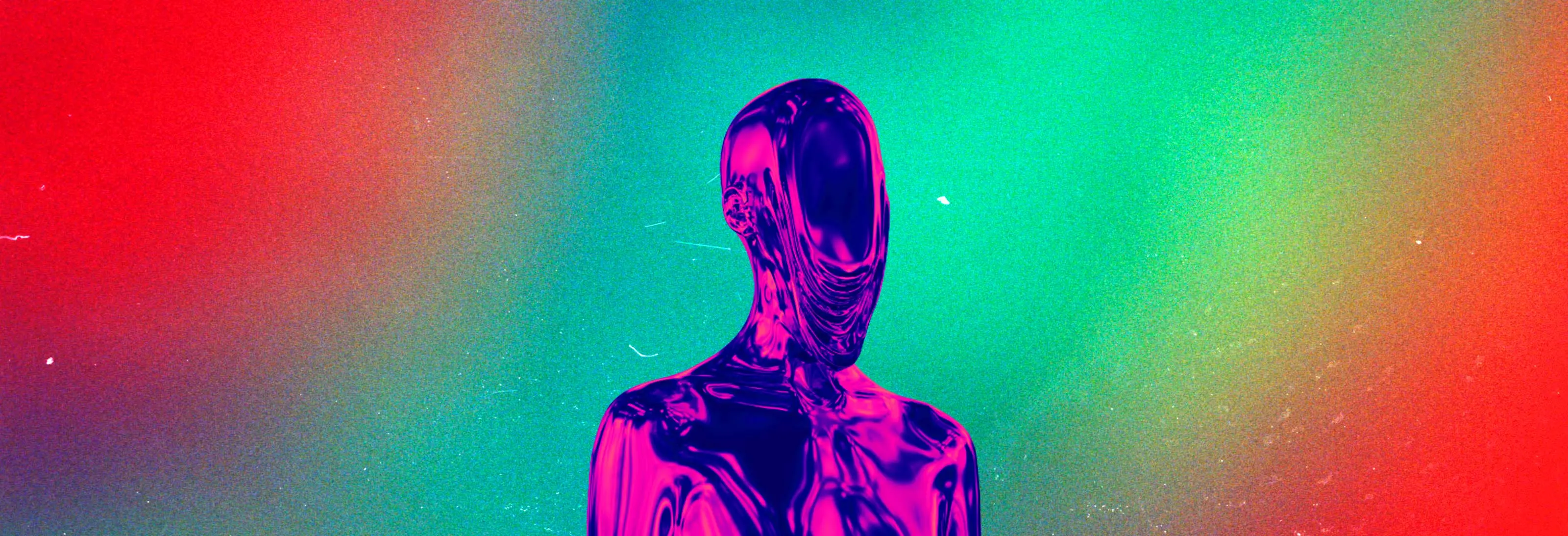


 Why such a close connection?
Why such a close connection?
 He speculates that magic acts might actually serve a role in cognitive function—namely, allowing us to hold contradictory beliefs.
He speculates that magic acts might actually serve a role in cognitive function—namely, allowing us to hold contradictory beliefs. 











 Click for more about memberships:
Click for more about memberships: